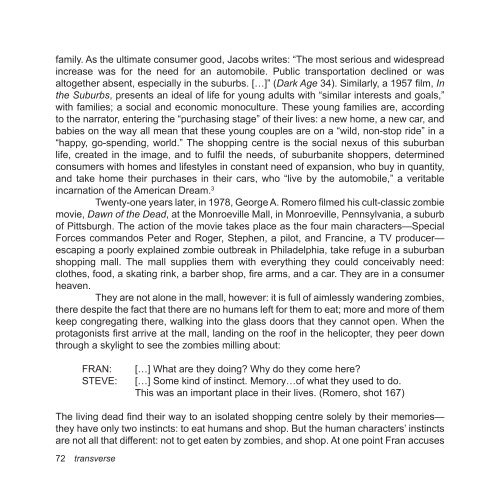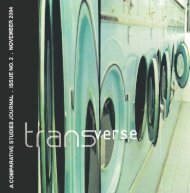Untitled - Centre for Comparative Literature - University of Toronto
Untitled - Centre for Comparative Literature - University of Toronto
Untitled - Centre for Comparative Literature - University of Toronto
Create successful ePaper yourself
Turn your PDF publications into a flip-book with our unique Google optimized e-Paper software.
family. As the ultimate consumer good, Jacobs writes: “The most serious and widespread<br />
increase was <strong>for</strong> the need <strong>for</strong> an automobile. Public transportation declined or was<br />
altogether absent, especially in the suburbs. […]” (Dark Age 34). Similarly, a 1957 fi lm, In<br />
the Suburbs, presents an ideal <strong>of</strong> life <strong>for</strong> young adults with “similar interests and goals,”<br />
with families; a social and economic monoculture. These young families are, according<br />
to the narrator, entering the “purchasing stage” <strong>of</strong> their lives: a new home, a new car, and<br />
babies on the way all mean that these young couples are on a “wild, non-stop ride” in a<br />
“happy, go-spending, world.” The shopping centre is the social nexus <strong>of</strong> this suburban<br />
life, created in the image, and to fulfi l the needs, <strong>of</strong> suburbanite shoppers, determined<br />
consumers with homes and lifestyles in constant need <strong>of</strong> expansion, who buy in quantity,<br />
and take home their purchases in their cars, who “live by the automobile,” a veritable<br />
incarnation <strong>of</strong> the American Dream. 3<br />
Twenty-one years later, in 1978, George A. Romero fi lmed his cult-classic zombie<br />
movie, Dawn <strong>of</strong> the Dead, at the Monroeville Mall, in Monroeville, Pennsylvania, a suburb<br />
<strong>of</strong> Pittsburgh. The action <strong>of</strong> the movie takes place as the four main characters—Special<br />
Forces commandos Peter and Roger, Stephen, a pilot, and Francine, a TV producer—<br />
escaping a poorly explained zombie outbreak in Philadelphia, take refuge in a suburban<br />
shopping mall. The mall supplies them with everything they could conceivably need:<br />
clothes, food, a skating rink, a barber shop, fi re arms, and a car. They are in a consumer<br />
heaven.<br />
They are not alone in the mall, however: it is full <strong>of</strong> aimlessly wandering zombies,<br />
there despite the fact that there are no humans left <strong>for</strong> them to eat; more and more <strong>of</strong> them<br />
keep congregating there, walking into the glass doors that they cannot open. When the<br />
protagonists fi rst arrive at the mall, landing on the ro<strong>of</strong> in the helicopter, they peer down<br />
through a skylight to see the zombies milling about:<br />
FRAN: […] What are they doing? Why do they come here?<br />
STEVE: […] Some kind <strong>of</strong> instinct. Memory…<strong>of</strong> what they used to do.<br />
This was an important place in their lives. (Romero, shot 167)<br />
The living dead fi nd their way to an isolated shopping centre solely by their memories—<br />
they have only two instincts: to eat humans and shop. But the human characters’ instincts<br />
are not all that different: not to get eaten by zombies, and shop. At one point Fran accuses<br />
72 transverse




